Fred Martin
A Retrospective, 1948-2003
Catalog illustrations with commentaries...
Catalog nos.
30-54
Click for
Catalog
nos. 1-26.
Catalog
nos. 55-63
Catalog
nos. 65-77
Catalog
nos. 78-115
Catalog
nos. 119-137
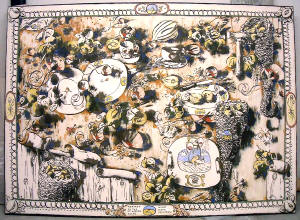 |
Cat. no. 30. #18, Harvest
on the Mt. Veeder Road, September 16, 1967.
Acrylic on canvas, 66 x 92 in. Collection Oakland Museum of
California.
I had been painting the Carpenter paintings for about a year
when I took forty or fifty of them to show to my then New York art
dealer. He did not like them; and on the plane on the way home, I
read in Darby Bannard’s The New Art something like “the glory
of American painting is its majestic size.” When I got home, I
rearranged my small studio to paint majestic size. If size made the
big boys glorious, maybe it would do it for me. I began to paint the
24 x 36 inch Carpenters as repeats all over 66 x 92 inch
canvases. Then I saw the quinces ripening on a tree in our backyard,
and I went back to Beulah Land—but as large as “the glory of American
painting.” One late summer afternoon, I went looking for an artist I
knew who had moved to Mount Veeder Road somewhere near the Napa
Valley. I did not find him, but came home and painted Cat. no. 30 as
the result.
|
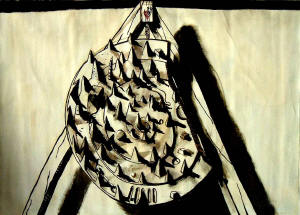 |
Cat. no. 31 #25,
Large Corn Sheller Wheel, January 5, 1968.
Acrylic on
canvas, 66 x 92 in.
I found a curious object in a junk store in Sonoma County. It was a
tool with a toothed wheel to tear the kernels from corn cobs to make
cattle feed. I had made images of corncobs loaded with corn as
phallic symbols of fertility; and in this wheel I found the image of
all the pain of family life. I made many drawings of the “corn
sheller,” and then made this big painting of its toothed wheel as an
object hung on an A-frame in a barn for everyone to see. I carved the
top of the frame with a heart for love and pounded into it a nail for
the husband and another for the wife… nails forever inextricable in
the wood of the A frame of the family tree that holds the wheel of
life in the barn of the Western Homestead in eternity. And as for the
shining medallion at the center of the necklace in eternity, there’s
no great beauty without fear and no great love without pain.
|
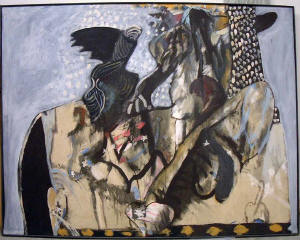 |
Cat. no. 32. #54, Johnny
America Still Life, November 9-11, 1968.
Acrylic on canvas, approx 66 x 92 in.
Collection Oakland Museum of
California.
I had made many big paintings to make me glorious, but I began to feel
that the imagery was too fixed—like the melody of a folk song instead
of the complex variability of a symphonic theme. One summer afternoon
in 1968, I saw what seemed to be a half nude man coming up out of Lake
Merritt. High cirrus clouds were curling in the sky above his head.
That night I decided whenever a form in my big paintings started to
close like a folk melody I would break it with another form only that
form would be broken in turn. Out of that streaming of broken
forms—the “primary process” speaking from the unconscious—I would then
use all my art-craft to make a whole out of parts. Looking back, the
man coming out of the lake was my “primary process” saying “LOOK AT
ME,” and the curling cirrus in the sky was the streaming of my art to
come.
|
|
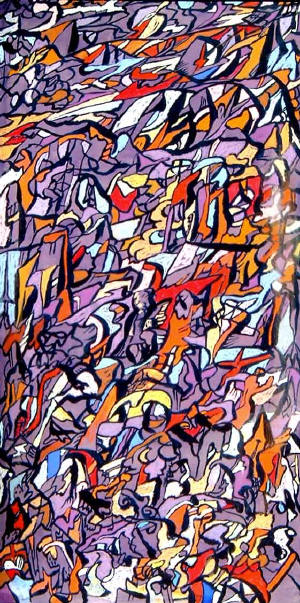 |
Cat. no. 40. From Dust of
Paradise Harvest, The Well Tempered Spectrum: Violet. 1970.
Pastel and acrylic on Masonite, 48 x 24 in.
Collection Oakland Museum
of California.
In the summer of 1970, I had been using acrylic for four years and had
yet to find a way to develop color like a composer might orchestrate a
symphony from a piano score. (The symphonic was then my visual
ideal.) After the 106th acrylic of “majestic” size (cat.
no. 48 in this show), I got real about scale—smaller—and switched to
colored sticks of soft pastel so I could hold a rainbow in my hand.
I kept on with the streaming lines of the big acrylic paintings, but
I filled the spaces between with the soft pastels. I called the new
work The Dust of Paradise Harvest, and I made a
Well-Tempered Spectrum (remembering Bach’s Well-Tempered
Clavier). This Violet is the last of the spectrum
series. The whole series showed the mountains of paradise, the heart
from the Western Homestead, and the winged sword of my masculinity—all
in the streaming of colors of the waters of life.
|
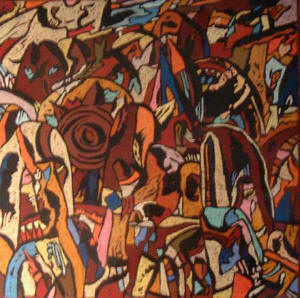 |
Cat. no. 41.
Afghanistan. 1971.
Pastel on Masonite, 18 x 18 in.
Late in
1970 I learned I was to receive an NEA grant for any purpose of my
choice. I had been reading Mortimer Wheeler’s Splendors of the
East and chose to see the places in the book by traveling around
the world. I was making work in the manner of the streaming of the
late-summer 1970 Dust of Paradise Harvest series, but by winter
that year I had begun to make images of specific places of my
imagination, like this Afghanistan, which came from reading of
the Kingdom of Prester John, the mythical history of Alexander and
the gates they said Alexander made to save the West from the violent
tribes of Gog and Magog. My trip around the world in the spring of
1971 began before I had finished this painting. I was proud that I
was able to complete the painting when I came back six weeks later.
|
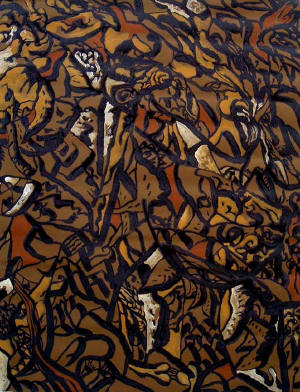 |
Cat. no. 45. #83,
September 7, 1969.
Acrylic on canvas, approx. 92 x 66 in.
The necklace in
eternity and the mountains beyond the far horizon are eternal time and
infinite space. But I was painting in our finite world of passing
time. The ancient Iranians had a god, Zurvan, the god of “the
time of long duration” and of the vast and time swept deserts of
Iran. The Gnostic god of time was Aion. He had the head of a
lion because time eats everything. He had wings because time goes
everywhere. He was wound with a snake carved with sun, moon, and the
five planets for time’s fatality. What has that to do with this
painting? I was imagining the plains and mountains of Central Asia
and the old old land of Zurvan with Aion ravaging through its
ruins. And I saw there a golden tree with singing birds that was my
love for my wife and our lives together in time. Stones from the
broken necklace are everywhere if we can see their shining.
|
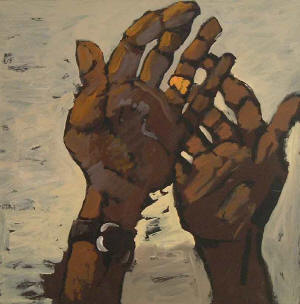 |
Cat. no. 54. My Hands in the Sun. 1971.
Oil on Masonite, 18 x 18 in.
I made slides on the
trip around the world because I did not think I could paint while
traveling—in the 1980’s, I learned I could (see cat. nos. 124-128). I
did not know how to use the slides when I got back, but I was sure I
had to quit the “streaming” pastels of before the trip. I went to oil
in order to show as clearly as possible what most mattered to me. The
first of the “matters most” was a painting of some poppies growing in
a cracked sidewalk just down from our house (cat. no. 51). And then I
began to make my body—my torso better built than I was (cat. no. 52),
my solar plexus with a tattoo that I do not have of a sunrise heart
(cat. no. 53), and then my hands raised in the sun. The hands wear
the ring I still wear. I made the ring into a golden mandala with
four small diamonds when I married Stephanie Dudek thirty years after
this painting was made.
|
|
|
|
Click for
Catalog
nos. 1-26.
Catalog
nos. 30-54
Catalog
nos. 55-63
Catalog
nos. 65-77
Catalog
nos. 78-115
Catalog
nos. 119-137
|